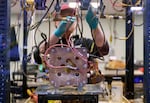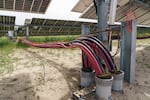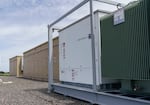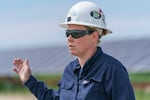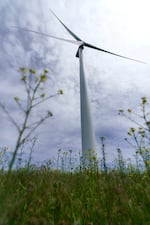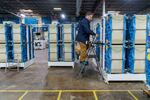
Sergiu Erhan checks batteries before they are shipped, Feb. 1, 2023, at ESS Inc. in Wilsonville, Ore. ESS manufactures iron flow batteries used for long-duration storage. This type of energy storage is an important component in building renewable power grids that can balance demand supply and demand peaks.
Kristyna Wentz-Graff / OPB
From the outside, ESS Inc.’s headquarters is the type of warehouse thousands of commuters on I-5 pass by everyday without giving it a second look. The trees surrounding the blue building make it look small and peaceful.
But inside it bustles with energy — both from the chatting workers and from the technology they’re building.
“This is really where in a way it kind of all starts,” said Eric Dresselhuys, who serves as CEO for the battery maker in Wilsonville. “The incoming materials flow in here and you can see the number of parts that it takes to make a battery.”
Dresselhuys pointed to organized shelves filled with tools, screws and pipes of all shapes and sizes. As he walked along the 250,000-square-foot warehouse, the rooms opened up to different construction stages of the company’s iron flow battery.
The battery can last more than 25 years and can store up to 12 hours of energy, according to ESS, though the company has not deployed any with that capacity into projects yet. The battery chemistry requires iron, salt and water, which are more abundant than elements of other popular batteries, like lithium-ion. The battery can also be recycled, according to ESS.
During a tour of the warehouse, Dresselhuys stopped in front of a room that’s used to test out smaller versions of the battery cells.

Karana Dunn works in the research and development department at ESS Inc., in Wilsonville, Ore., Feb. 1, 2023. ESS manufactures iron flow batteries used for long-duration storage. This type of energy storage is an important component in building renewable power grids that can balance demand supply and demand peaks.
Kristyna Wentz-Graff / OPB
“This is the lab, which I always think looks like Dr. Frankenstein was here,” he said. “We test different electrolytes and different chemistries inside these units. Some of these have been operating for eight, nine, 10 years.”
As the U.S. rushes to figure out how to meet a climate goal of a 100% clean energy by 2050, power producers are increasingly turning to renewable energy from sources like wind and solar. In Oregon, some utilities have begun ramping up renewable energy to meet the state’s clean energy goals, but there’s a problem: The energy generated from these sources can only be used when the wind is blowing or the sun is shining, and holding onto this energy has proven challenging because battery storage on the utility grid is limited.
Experts say battery storage will play a major role in achieving our clean energy goals, but there needs to be improvements to current capabilities. In the Pacific Northwest, companies like ESS, as well as researchers, are pouring millions of dollars into projects they hope will put them on the cutting-edge of a technology that’s getting a clean energy revamp.
‘We’re at a tipping point’
The continued burning of fossil fuels like gasoline, coal and natural gas is contributing to human-caused climate change. In the Northwest, it’s resulted in more extreme weather events like intense wildfires, deadly heat domes and drought.
Renewables like hydropower, wind and solar are making up an increasingly large share of the electricity used by Oregonians. But about 29% of the state’s greenhouse gas emissions still come from electricity use, according to the Oregon Department of Energy.
Oregon is requiring utilities like Portland General Electric and Pacific Power to end carbon emissions by 2040, but battery technology is needed to hit those goals.

Robot assembly of batteries at ESS Inc. in Wilsonville, Ore., Feb. 1, 2023. ESS manufactures iron flow batteries used for long-duration storage. This type of energy storage is an important component in building renewable power grids that can balance demand supply and demand peaks.
Kristyna Wentz-Graff / OPB
That need is evident at PGE’s Wheatridge Renewable Energy Facility in Eastern Oregon. The first-of-its-kind wind, solar and battery facility generates up to 350 megawatts of clean energy. That’s enough to power 100,000 homes. But batteries at Wheatridge can’t store all that power. In fact, the facility can hold just a fraction of that — 30 megawatts, or enough to power the city of Tigard for four hours. The batteries are also located at the facility, which could result in energy being lost as it’s dispersed long distances to cities like Portland.
Dresselhuys said technology like ESS’s iron flow battery could help with distributing electricity where it’s needed most in Oregon.
“Batteries can play a big role in helping [grid operators] manage where electricity flows go across the grid and get more out of the infrastructure that we have,” Dresselhuys said.
The company has partnered with PGE to test out a 3-megawatt-hour battery as an alternative to lithium-ion batteries currently in use. Dresselhuys said as the need for energy storage grows, Oregon will need a diverse set of technologies to retain power from varied sources.
“I expect that there will be a number of different technology approaches that will come,” he said. “Some will be better suited for some applications than others.”
Currently, lithium-ion batteries dominate the battery industry because of the rechargeable capabilities and their size and weight. These batteries are everywhere — cellphones, laptops, headphones and electric vehicles.
But lithium has its limits. The lifespan and charging hold of these batteries can only do so much.
Environmentalists and Indigenous tribes have also grown concerned about mining lithium, a fight that is at Oregon’s southern border as developers seek to extract a major lithium deposit in northern Nevada. Prospectors have also eyed lithium deposits in Oregon. According to the International Energy Agency, a collective of 31 countries including the U.S. that develops sustainable energy policy recommendations, the world could also face a lithium shortage by 2025.
Julia Souder is the executive director for the Long Duration Energy Storage Council, a nonprofit that works on decarbonization. She said despite their problems, lithium-ion batteries have been a stepping stone to other technologies.
“It’s been a great tool to educate us all on the importance of batteries and while we need storage, we need to keep pushing ourselves to innovate and get them to be better and be improved,” she said.
For years, there has been research like that at ESS to create alternative battery chemistries, from sodium-ion to potassium to magnesium to calcium. But many of these chemistries are either still being developed or, just like any research, fail.
But Souder said ambitious climate goals like those passed in Oregon in recent years are pushing advancements in long-duration energy storage.
“We’re at a tipping point,” she said. “Five years ago this term was not really understood and I think the next two years it will be very well understood, especially as we’re adapting to climate change.”
Northwest research
Through the Bipartisan Infrastructure Law, the U.S. plans to spend $7 billion to strengthen its battery supply chain and find ways to recycle critical minerals like lithium from used batteries.
Some researchers, such as Oregon State University chemistry professor Xiulei “David” Ji are at the forefront of the research. Ji is leading a team across the country using a $3 million grant from the U.S. Department of Energy to develop a sustainable, rechargeable battery.
“It’s going pretty well,” he said. “We have observed some encouraging results, so I’m very hopeful.”
Ji said it takes a long time to develop a battery chemistry that can be safe and ready for mass production, which is why lithium-ion has remained one of the most attractive technologies.
But, he said, technologies being developed in the Pacific Northwest like those from ESS or the Pacific Northwest National Laboratory are making notable advances.
PNNL, a branch from the U.S. Department of Energy’s Office of Science, recently announced it has created a battery design built with low-cost metals sodium and aluminum that could provide a safer alternative for long-duration energy storage.
Ji said having some friendly competition is necessary to push technology forward, but he hopes eventually everyone starts to work together.
“The more people who are thinking about this question, this challenge, the better the society will be in terms of addressing the energy storage challenge right now,” he said.
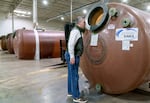
Eric Dresselhuys, chief executive officer at ESS, Inc., looks inside a tank at the Wilsonville manufacturing plant, Feb. 1, 2023. ESS manufactures iron flow batteries used for long-duration storage. This type of energy storage is an important component in building renewable power grids that can balance demand supply and demand peaks.
Kristyna Wentz-Graff / OPB
Full life cycle equals recycle
On the other side of developing a sustainable battery is how recyclable it can be. That’s a question the Oregon Department of Environmental Quality is starting to examine.
“Right now, there is some recycling of car batteries, it’s pretty rudimentary. It’s relying a lot on mechanical recycling, shredding up the batteries and pulling out the obvious larger chunks of metals that can be recovered,” DEQ’s materials management specialist Pete Pasterz said.
According to a 2022 report from a subsidiary of the American Chemical Society, only 5% of the world’s lithium-ion batteries may be recyclable at this time. Pasterz said that needs to change as the battery boom continues and the demand for more EVs and clean energy storage grows. Pasterz said people in the industry must determine how the minerals used in old batteries be extracted and put back into production.
Finding breakthroughs in the life cycle of batteries, according to Pasterz, will be essential in Oregon’s ability to store energy on the grid.
Even though batteries can seem like a technology that has been slow to evolve — lithium-ion technology was first introduced to the mass market in the late 1980s — Pasterz said changes can happen quickly when there is focus.
He pointed to light bulbs as a recent example.
Incandescent bulbs were popular for many years, until companies turned to fluorescent bulbs that were more energy efficient and cooler to the touch. But those bulbs contain mercury and release it into the air when broken, making them dangerous. Now, LED lights probably light your living space.
“There are still challenges and a lot of it has to do with the evolutionary sense of any kind of technology,” he said. “Things are invented, they’re improved upon and over time, they become just part of our daily lives.”
Right now, Pasterz said, we’re at that incandescent bulb stage of battery technology. Research and testing takes time. He said not all technologies are going to succeed. Some will fail like fluorescent bulbs did.
Others like ESS’s could take off.
ESS has only deployed battery storage systems that provide about five hours of storage, and they’ve faced delays in getting projects out at times. Despite a few setbacks, the company will be testing out a battery with PGE later this year that could store about eight hours of electricity — a promising advance in the clean energy boom.




